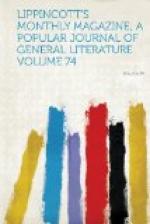Portraiture being the highest and most difficult labor to which an artist can aspire, to this branch of art Hunt has chiefly confined himself, and from this point of view he must be studied. We do not forget, in saying this, his angel with the flaming torch, strong and beautiful and of unearthly presence, nor the shadowy, half-portrayed figures which dart and flit across his easel; but as we may understand the power of Titian from his portraits, yet never revel in it fully until we look upon “The Presentation” or “The Assumption”—never comprehend the painter’s joy or his divine rest in endeavor until the achievement lies before us—we must speak of Hunt only from the work to which he has devoted himself, and not do him the injustice to predict dramas he has never yet composed.
First, pre-eminently appears that worship for moral beauty which suffers him to fear no ugliness. This power allies him with keen sympathy to every living thing. He sees kinship and the immortal spark in each breathing being. The soul of love goes out and paints the dark or the suffering or the repellant faithfully, bringing it in to the light where God’s sunshine may fall upon it, and men and women, seeing for the first time, may help to wipe away the stain. This tendency he shares with the great French painter Millet, whom he loves to call Master, and with Dore, whose terrible picture of “The Mountebanks” should call men and women from their homes to penetrate the fastnesses of vice and strive to heal the sorrows of their kind.
This love of moral beauty, which forces painters to paint such pictures, was never in any age more evident. Hunt in his beggar-man, in his forlorn children, and other pictures of the same class, unfolds a beauty that men should be thankful for.
On the other hand, his love of beauty and his power of expressing it should be studied in its direct influence. The beauty of flesh and blood, even the loveliness of children, seems to have slight hold upon him, compared with the significance of character and the lustre with which his imagination endows everything. This lustre is a distinguishing power with him. The depth to which he sees and feels causes him to give higher lights and deeper shadows than other men. White flowers are not only white to him—they shine like stars. His pictures give a sense of splendor.
In his sketch of the poor mother cuddling her child, it is the feeling of rest, the mother’s sleeping joy, the relaxed limbs, the folding embrace, which he has given us to enjoy. These are the beauty of the picture—not rounded flesh, nor graceful curves, nor fair complexion; and so with the singing-girls: they are not beautiful girls, but they are simple—they love to sing, they are full of tenderness and music. We might go over all his pictures to weariness in this way. The young girl plucking at the daisy as she stands in an open field must, however, not be omitted. The natural elegance of this portrait renders it peculiarly, we should say, such a one as any woman would be proud to see of herself. Doubtless this young girl, like others, may have worn ear-rings and chains and pins and rings, but the artist knew her better than she knew herself, and has portrayed that exquisite crown of simplicity with which, it should seem, Nature only endows beggars and her royal favorites.




